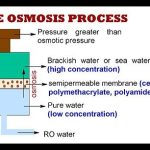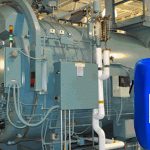The most harmful of the dissolved gases is oxygen, which can cause pitting of metal. Very small amount of oxygen can cause severe damage, a mixture of oxygen and water is a highly corrosive combination. This corrosive nature doubles with every 18 deg. F increase in temperature. Further the corrosion of iron forms soluble bicarbonate, which leaves no protective coating on the metal. If oxygen is also present, rust forms and CO2 is released, which is free to form more corrosion.
Oxygen corrosion can be recognized by pits, typically found in the top of the steam drum or at the water line. Oxygen pitting & scale formation can destroy piping and boiler tubes as well as interfere with heat transfer and the operation of pressure reducing valves & trap mechanism.
Oxygen can be removed from the feed water, both by mechanical or chemical de-aeration
The amount of dissolved oxygen present in water is very much dependent on the feed water temperature. The solubility of oxygen in water is reduced as the temperature of the water increases. The dissolved oxygen content of water at 20 °C is 9ppm, at 60 °C is 5 ppm and at 90 °C is just under 2 ppm. At 100 °C the oxygen content is theoretically 0 ppm.
The removal of oxygen by heating (e.g direct steam injection) reduces the requirement of expensive oxygen scavenging chemicals (most often sodium sulphite), the addition of which actually leads up to increased feed water TDS and longer blowdowns.
Direct seam injection is one of the most efficient methods for boiler feed tank heating. A de-aerator can be used to heat feedwater by mixing it rigorously with hot condensate and flash steam. This process can vent off dissolved gases. The animation below describes the working of a de-aerator.
Atmospheric boiler-feed tanks are normally operated at approximately 85-95 °C, which leaves an oxygen content of around 2mg/liter (ppm). It is not possible to operate at higher temperatures due to the possibility of cavitation in feed pump and close proximity to saturation temperature.
Complete removal requires additional chemical treatment. One process used is the addition of catalysed sodium sulphite.
2NA2SO3 + O2 —-> 2NA2SO4
In the reaction one pound of oxygen will consume 7.88 pounds of pure catalyzed sodium sulphite. In practice, about 10 pounds per pound of oxygen are added to carry a small excess of sulphite in the boiler water. Higher sulphite will not only be waste full but will also increase the TDS of boiler water which will in turn increase the required blowdown rate & hence higher losses.
EFFECTS OF CARBON DIOXIDE
The most prevalent type of condensate system corrosion is caused by carbon dioxide. A great part of condensate recovery system failure can be traced to a feed water treatment problem that allows carbon dioxide to enter the distribution system piping. Carbon dioxide enters the system with the boiler feed water in dissolved form & in form of bicarbonates. The carbon dioxide is carried away with the steam & is condensed to form carbonic acid. Carbonic acid has a capacity to combine with one and a quarter pound of steel per pound of CO2, forming a groove at the bottom of the piping . Over years this eat up a lot of metal & causes numerous other problems.
CO2 + H2O ——> H2CO3
Heating the feed water and maintaining it at a high temperature prior to its delivery to boiler, in the feed tank can drive off both oxygen & free carbon dioxide. Any remaining oxygen can then be dealt with by the addition of a chemical oxygen scavenger such as catalyzed sodium sulphite.



Comments are closed